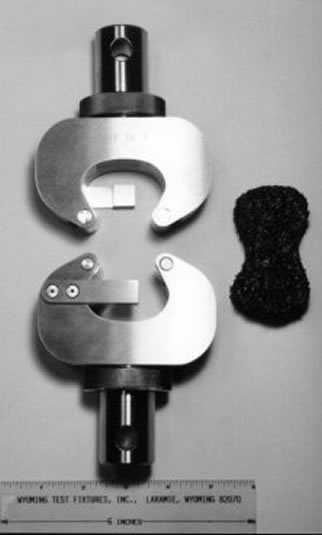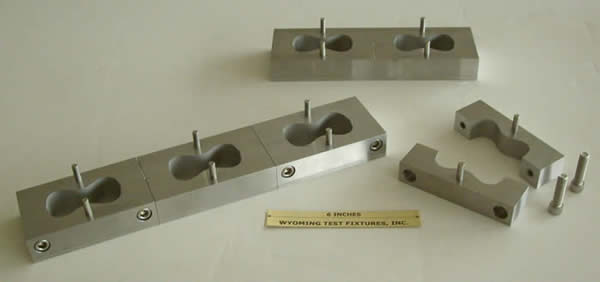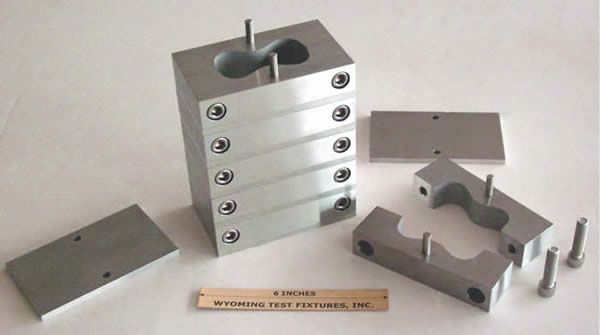Briquet Tensile Testing Grips (ASTM C307)
Model No. WTF-BC (Stainless Steel)

Fig. 1: Views of Tensile Grips: front (top) and rear (bottom) with typical briquet specimen shown at right.
This test method first became an ASTM standard in 1953. The fixture consists of identical upper and lower grips, termed clips in ASTM Standard C307 (Reference 1), and is designed to determine the tensile strength of specially-shaped briquets of mortar, grout, and similar other monolithic surfacing materials.
Fig. 1 shows a pair of grips, the top grip being viewed from the front side and the bottom grip from the back side. A typical briquet specimen is also shown at the right. The stop plates on the grips center the specimen fore and aft.
The specimen is loaded on its four shoulders via the rollers at the ends of the grips. The outer end of each grip contains a threaded hole, to accommodate whatever type of testing machine attachment is required. Shown in Fig. 1 are standard Instron Type Dm (1.25 in. diameter stud with 1/2 in. diameter crosspin hole) male adapters for attachment to the crosshead and base of the testing machine.
The molded briquet specimen is 3 in. long, approximately 1 3/4 in. wide at its ends, 1 in. wide in the central gage section, and of 1 in. uniform thickness. Specific dimensions are given in ASTM Standard C307.
One or more briquet gang molds, typically each containing one to three cavities, can be provided upon request. The ASTM standard specifies that six specimens be prepared for each test period. Full details of molding test specimens, conditioning them, performing the mechanical testing, and then reporting the data are given in ASTM Standard C307. The fixtures as supplied by Wyoming Test Fixtures, Inc. conform directly to the fixture geometry suggested in the ASTM standard.
One example is shown in Figs. 2 and 3. Either a single mold consisting of a containment block and a base plate, or several of these single molds can be used, as indicated in Fig. 2. Or these molds can be stacked, as shown in Fig. 3. Other mold designs are also available.

Fig. 2: Single and Multiple-cavity molds

Fig. 3: Stacked single-cavity molds
Source of Additional Information:
1) ASTM Standard C307-03 (2012), "Tensile Strength of Chemical-Resistant Morter, Grouts, and Monolithic Surfacings," American Society for Testing and Materials, West Conshohocken, PA (first issued in 1953).

